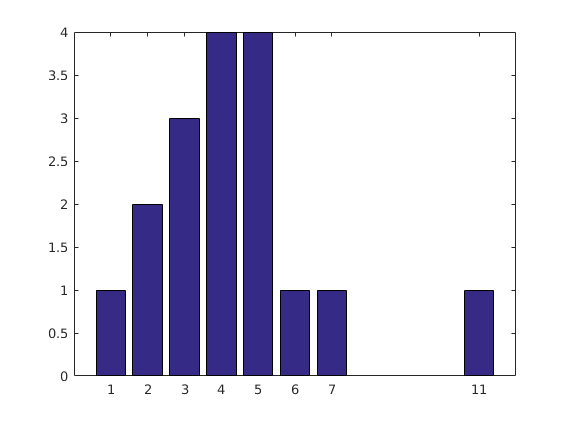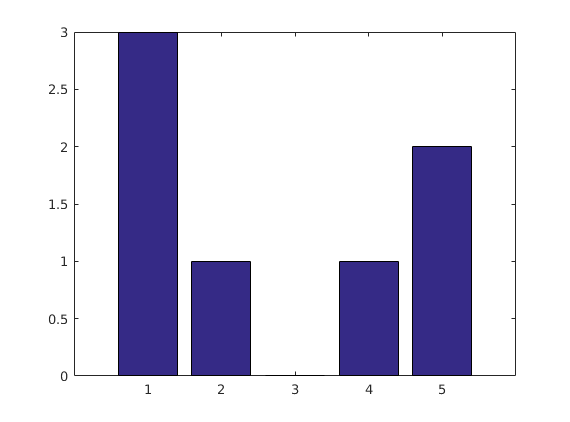How do I count the occurrences of each element in a vector
HA 16.8.2016 I came up to such questions when working on the Hardy-Ramanjan problem:
https://math.aalto.fi/opetus/Mattie/Blogi/Matlab/html/HardyRamanujan.html
After my way of counting using sort and diff presented above, I found this discussion with variuos interesting solutions to related problems. In this "publish-worksheet" I studied and ran through many of them for my own learnig and joy.
Contents
- Set from sequence, "unique"
- Number of duplicates in many ways:
- 1. Logical indexing, for-loop
- 2. sort, diff, logical indexing, no loops
- 3. hist gives the data right away
- histc help
- 4. Solution with histc
- 5. arrayfun, nnz
- 6. Variant: Count the number of occurrences of each integer 1,2,...
- 6 b) another solution
Set from sequence, "unique"
Matlab has the command unique. To practice "more primitive" ways, let's use logical indexing and diff.
sequence=[1 2 2 3 3 3 4 4 4 4 11 5 5 5 5 6 7] w=sort(sequence); b=diff(w); I=b~=0 I=logical([1 I]) set=w(I)
sequence =
Columns 1 through 13
1 2 2 3 3 3 4 4 4 4 11 5 5
Columns 14 through 17
5 5 6 7
I =
Columns 1 through 13
1 0 1 0 0 1 0 0 0 1 0 0 0
Columns 14 through 16
1 1 1
I =
Columns 1 through 13
1 1 0 1 0 0 1 0 0 0 1 0 0
Columns 14 through 17
0 1 1 1
set =
1 2 3 4 5 6 7 11
unique(sequence) % does the same
ans =
1 2 3 4 5 6 7 11
help unique, doc unique show lots of optional uses. type unique shows the code, a lot more complicated then the above lines but of course does a lot more.
Number of duplicates in many ways:
1. Logical indexing, for-loop
x=[10 25 4 10 9 4 4] y = zeros(size(x)); for i = 1:length(x) y(i) = sum(x==x(i)); end y % This was my first attempt in HardyRamanujan. % Inefficient if lots of data, took incredibly long when p=4. %
x =
10 25 4 10 9 4 4
y =
2 1 3 2 1 3 3
2. sort, diff, logical indexing, no loops
In HardyRamanujan-ws I proceeded along theses lines, the first difference was enough.
v=[1 2 2 3 3 3 4 4 4 4 11 5 5 5 5 6 7] w=sort(v) I1=diff(w)
v =
Columns 1 through 13
1 2 2 3 3 3 4 4 4 4 11 5 5
Columns 14 through 17
5 5 6 7
w =
Columns 1 through 13
1 2 2 3 3 3 4 4 4 4 5 5 5
Columns 14 through 17
5 6 7 11
I1 =
Columns 1 through 13
1 0 1 0 0 1 0 0 0 1 0 0 0
Columns 14 through 16
1 1 4
pick1=logical(I1==0) AL1dup=w(pick1) % At least 1 duplicate % I2=diff(AL1dup) pick2=logical(I2==0) AL2dup=AL1dup(pick2) % At least 2 duplicates % I3=diff(AL2dup) pick3=logical(I3==0) AL3dup=AL2dup(pick3) % At least 3 duplicates % Works, not very elegant, though
pick1 =
Columns 1 through 13
0 1 0 1 1 0 1 1 1 0 1 1 1
Columns 14 through 16
0 0 0
AL1dup =
2 3 3 4 4 4 5 5 5
I2 =
1 0 1 0 0 1 0 0
pick2 =
0 1 0 1 1 0 1 1
AL2dup =
3 4 4 5 5
I3 =
1 0 1 0
pick3 =
0 1 0 1
AL3dup =
4 5
3. hist gives the data right away
[y,x]=hist(v,unique(v)) bar(x,y);shg [x;y] % % Elegant % To avoid one rare possibility, one can include an extra check: %{ Solution 2 (using hist()) runs into trouble if unique(x) boils down to one number (a scalar). Then hist() takes it as the number of bins to use, not a bin center. Some if/else logic would catch this. Not sure if there is a one line answer. %} ux = unique(x); if length(ux) == 1, counts = length(x); else counts = hist(x,ux); end counts
y =
1 2 3 4 4 1 1 1
x =
1 2 3 4 5 6 7 11
ans =
1 2 3 4 5 6 7 11
1 2 3 4 4 1 1 1
counts =
1 1 1 1 1 1 1 1

histc help
[N,BIN]=histc(x,unique(x)) % % [N,BIN] = histc(X,EDGES,...) also returns an index matrix BIN. If X is a % vector, N(K) = SUM(BIN==K) [N(BIN);x]
N =
1 1 1 1 1 1 1 1
BIN =
1 2 3 4 5 6 7 8
ans =
1 1 1 1 1 1 1 1
1 2 3 4 5 6 7 11
10 appears 2 times, 25 appears once, 4 appesra 3 times, ...
4. Solution with histc
x= [1 1 1 2 4 5 5]
[a,b] = histc(x,unique(x));
y = a(b)
% Works in general, perhaps requires some more thought than hist above.
x =
1 1 1 2 4 5 5
y =
3 3 3 1 1 2 2
5. arrayfun, nnz
y = arrayfun(@(t)nnz(x==t), x)
%
y =
3 3 3 1 1 2 2
6. Variant: Count the number of occurrences of each integer 1,2,...
%{ I'm working with a small variant of the original problem, where I want it to count the number of occurrences of each whole number (till 13). So if my input is x = [1,1,1,2,4,5,5] I need an output y = [3,1,0,1,2] How do I do this? %} x = [1,1,1,2,4,5,5] y = accumarray(x(:),1)
x =
1 1 1 2 4 5 5
y =
3
1
0
1
2
6 b) another solution
v=[1,1,1,2,4,5,5] numbers=unique(v) %list of elements count=hist(v,numbers) %provides a count of each element's occurrence % this will give counts. and if you want to have a nice graphical % representation then try this bar(accumarray(v', 1)) shg %{ Comment from the above site: When using hist() pay attention to Dan's comment above pointing out a flaw in the approach. This flaw is not shared by Andrei's histc approach above. %}
v =
1 1 1 2 4 5 5
numbers =
1 2 4 5
count =
3 1 1 2
